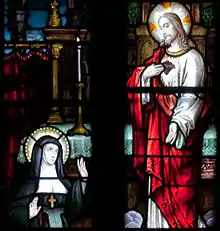Vision (spirituality)
A vision is something seen in a dream, trance, or religious ecstasy, especially a supernatural appearance that usually conveys a revelation.[1] Visions generally have more clarity than dreams, but traditionally fewer psychological connotations. Visions are known to emerge from spiritual traditions and could provide a lens into human nature and reality.[2] Prophecy is often associated with visions.

Illumination from Liber Scivias, showing Hildegard of Bingen receiving a vision, dictating to her scribe and sketching on a wax tablet.
About
Evelyn Underhill distinguishes and categorizes three types of visions:[3]
- Intellectual Visions - The Catholic dictionary defines these as supernatural knowledge in which the mind receives an extraordinary grasp of some revealed truth without the aid of sensible impressions and mystics describe them as intuitions that leave a deep impression.[4]
- Imaginary - In Teresa of Avila's The Interior Castle, an imaginary vision is defined as one where nothing is seen or heard by the senses of seeing or hearing, but where the same impression is received that would be produced upon the imagination by the senses if some real object were perceived by them.[5] Niels Christian Hvidt refers to them as visions recognized through mechanisms of the human psyche that are made up of things a soul has acquired through contact with reality.[6]
- Corporeal - A supernatural manifestation of an object to the eyes of the body. It may take place in two ways: either a figure really present strikes the retina and there determines the physical phenomenon of the vision, or an agent superior to man directly modifies the visual organ and produces in the composite a sensation equivalent to that which an external object would produce.[7] Underhill refers to this vision type as "little else than an uncontrolled externalization of inward memories, thoughts, or intuitions"[3]
Examples
Visions are listed in approximately chronological order whenever possible, although some dates may be in dispute.
- Vision of God in the first chapter of the Book of Ezekiel (6th century BC)[8]
- Vision of a heavenly figure "like a son of man" in Daniel 7:13 (6th century / 2nd century BC)[9]
- Post-resurrection appearances of Jesus
- St Paul's vision of Jesus on the road to Damascus (1st century)[10]
- Marian apparitions (visions or visitations of Mary, mother of Jesus) (1st century AD – present)[11]
- Visions of the afterlife in the martyr accounts of Perpetua and Felicity (2nd century AD)[12]
- Constantine's vision of Christ's sign (312 AD)[13]
- Jakob Böhme's vision (1600 AD), in which he observed the beauty of a beam of sunlight in a pewter dish[14]
- René Descartes' series of dreams on the night of 11 November 1619, which set the course of his life in science[15]
- Blaise Pascal's vision of 23 November 1654, which reinvigorated his spiritual commitment[16]
- Emanuel Swedenborg's visions, which formed the basis of a newly revealed doctrine (beginning in 1740s)[17]
- Joseph Smith's First Vision (1820), including Throne-Theophany of Lehi in the First Book of Nephi in 1 Nephi 1:8–11 (6th century BC)[18]
- The Three Witnesses: Oliver Cowdery, David Whitmer and Martin Harris claimed that they were shown the Book of Mormon's golden plates by an angel on 28 June 1829. They also stated that they heard a voice from heaven declaring that they were translated miraculously. With over 150 documented statements, it is the most well-documented vision in history.[19]
- Ramakrishna had several visions of religious figures including Kali, Sita, Krishna, Jesus, and Muhammed. (mid/late 19th century)[20]
- Nat Turner's vision of 12 February 1831, in which he saw an actual eclipse of the sun that day as a black man's hand covering the solar orb, interpreting it as a sign to launch his slave rebellion.[21]
See also
References
- "Definition of VISION". www.merriam-webster.com. Retrieved 13 July 2018.
- Schreuder, D.A. (2014). Vision and Visual Perception. Archway Publishing. p. 671. ISBN 978-1-4808-1294-9. Retrieved 13 July 2018.
- Underhill, E. (2017). Mysticism: A Study in Nature and Development of Spiritual Consciousness. Devoted Publishing. p. 148. ISBN 978-1-77356-004-5. Retrieved 16 July 2018.
- "INTELLECTUAL VISION". catholicculture.org. Retrieved 16 July 2018.
- Saint Teresa (of Avila) (1852). The Interior Castle, Or The Mansions. T. Jones. Retrieved 26 July 2018.
- Hvidt, N.C. (2007). Christian Prophecy: The Post-Biblical Tradition. Oxford University Press, USA. p. 137. ISBN 978-0-19-531447-2. Retrieved 16 July 2018.
- "Visions and Apparitions". NewAdvent.org. Retrieved 16 July 2018.
- Ezekiel 1:4–28
- "Daniel 7:13". biblehub.com. Retrieved 13 July 2018.
- "Acts 9:3-9". biblegateway.com. Retrieved 13 July 2018.
- Zimdars-Swartz, S.L. (2014). Encountering Mary: From La Salette to Medjugorje. Princeton Legacy Library. Princeton University Press. ISBN 978-1-4008-6163-7. Retrieved 13 July 2018.
- Akin, Jimmy. "Who Was the Early Visionary St. Perpetua?". NCregister. Retrieved 13 July 2018.
- Cruz, J.A.H.M.; Gerberding, R.A. (2004). Medieval Worlds: An Introduction to European History, 300-1492. Houghton Mifflin. p. 60. ISBN 978-0-395-56087-7. Retrieved 13 July 2018.
- "Boehme, Jacob". encyclopedia.com. Retrieved 13 July 2018.
- Keevak, Michael (1992). "Descartes's Dreams and Their Address for Philosophy". Journal of the History of Ideas. JSTOR. 53 (3): 373. doi:10.2307/2709883. ISSN 0022-5037.
- "Blaise Pascal Scientific and spiritual prodigy". christianitytoday.com. Retrieved 13 July 2018.
- Swedenborg, E. (1975). Small Theological Works and Letters of Emanuel Swedenborg. Swedenborg Society. Retrieved 13 July 2018.
- "First Vision Accounts", churchofjesuschrist.org, LDS Church, retrieved 16 July 2018
- Anderson, Richard L. (1989). Investigating the Book of Mormon Witnesses. Deseret Book Co. ISBN 9780877478461.
- Zaleski, P.; Zaleski, C. (2006). Prayer: A History. Houghton Mifflin Harcourt. pp. 162–163. ISBN 978-0-618-77360-2. Retrieved 27 July 2018.
- "Nat Turner's Rebellion". PBS.org. Retrieved 16 July 2018.
This article is issued from Wikipedia. The text is licensed under Creative Commons - Attribution - Sharealike. Additional terms may apply for the media files.
